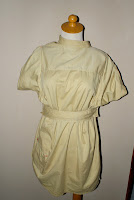... I make one. Not from scratch this time, but from a shirt a friend of mine gave me (cheers, Bry!). In tune with my principle of trying to consume less in all areas of life to tread more lightly on this earth, I have indeed not been clothes shopping in ages and ages. Conveniently for me, my friend has decided to bide one of his cotton work shirts farewell, as he has been working out lately and now many of his clothes are to big for him; he's really tall as well, so it's perfect dress-material for little me.
There are endless of ways of customizing shirts; they are one of the most satisfactory thinks to alter, as usually dress fabrics are nice. If you want to make one yourself, this is how I did mine:
1. detached sleeves and collar, cut a strip from the sleeves to sew together with collar to create belt
2. cut deeper neckline, front and back. make cord channel with strip from sleeve. insert cord, tack at back to fix rouching
3. detached and re-attached pocket to lower position
4. detached cuffs, reseamed them, buttoned to sleeves as detachable epaulets
5. finish armholes
6. take in side seam under the arm holes and finish side seam
7. attach belt at side seams; rouch at back waist for regular gathering
Transformation completed!
... or almost... I still have a little bit of material left from the sleeves. Now, I am against waste of any sort. So either I will use this to lengthen the hem a bit (more suitable to moslem Indoland) or make rosettes for decoration. Ideas?
 I am starting to customize another (short sleeve) shirt in a sunny yellow, as the other one looks lovely. First thing is changing the neckline, although I'm liking the sleeves so far (you can't see if properly on the pic but they are gathered on the top and left to drape underneath.
I am starting to customize another (short sleeve) shirt in a sunny yellow, as the other one looks lovely. First thing is changing the neckline, although I'm liking the sleeves so far (you can't see if properly on the pic but they are gathered on the top and left to drape underneath.










